外研版(2019)必修第二册:Unit 3 On the Move Using language课件(21张)
文档属性
| 名称 | 外研版(2019)必修第二册:Unit 3 On the Move Using language课件(21张) |  | |
| 格式 | pptx | ||
| 文件大小 | 3.5MB | ||
| 资源类型 | 教案 | ||
| 版本资源 | 外研版(2019) | ||
| 科目 | 英语 | ||
| 更新时间 | 2022-02-28 09:02:03 | ||
图片预览

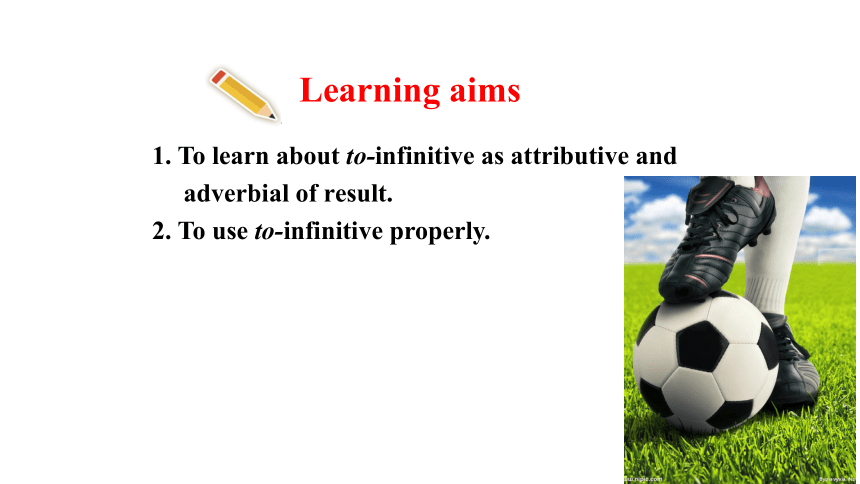
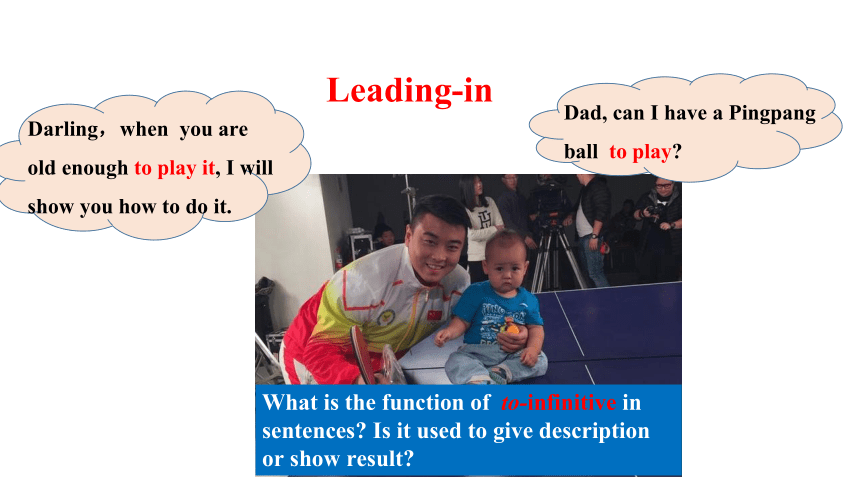
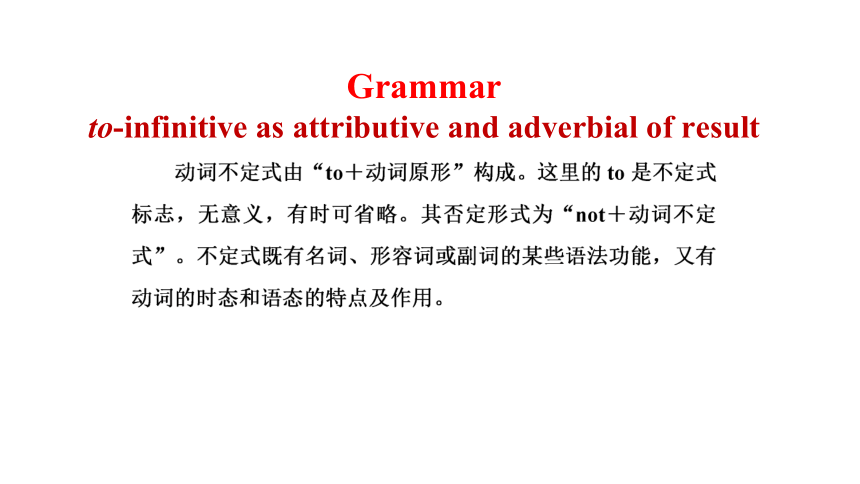
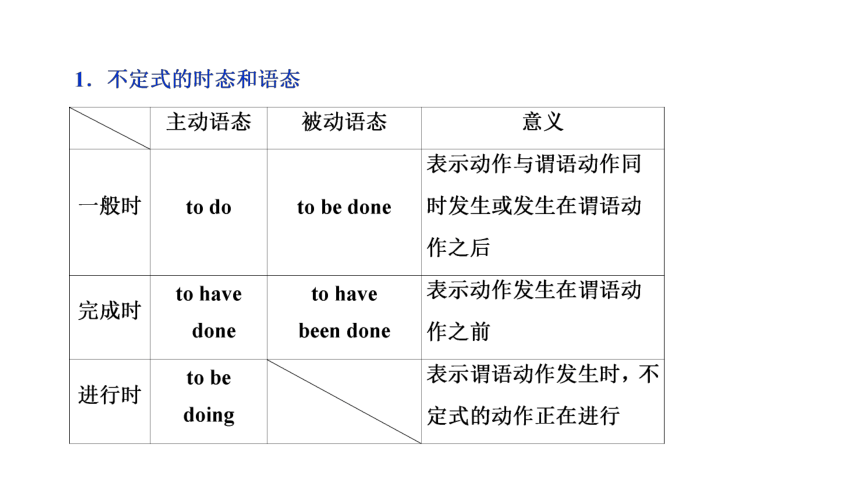
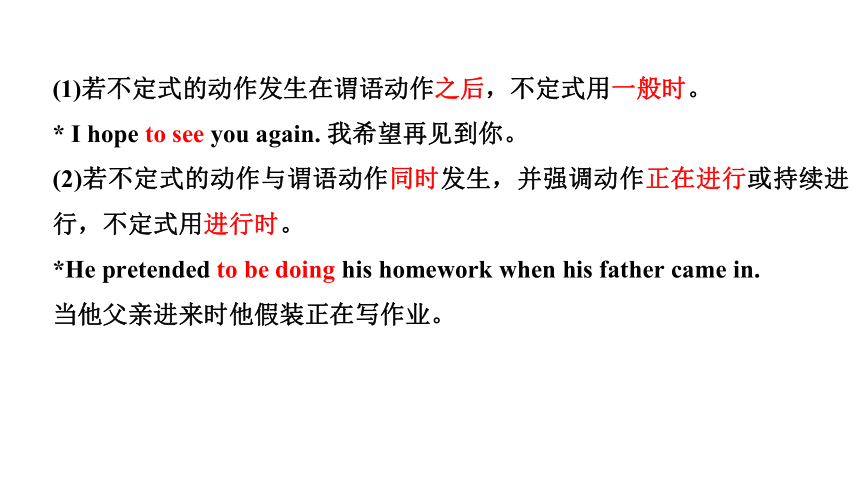
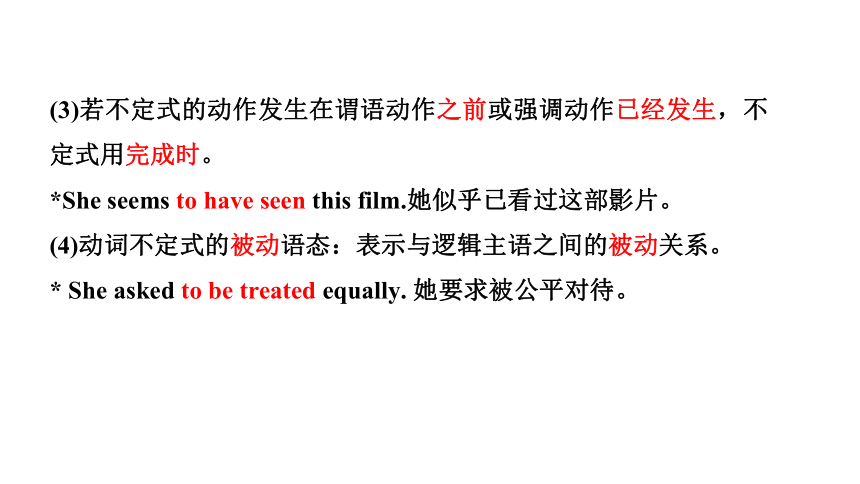
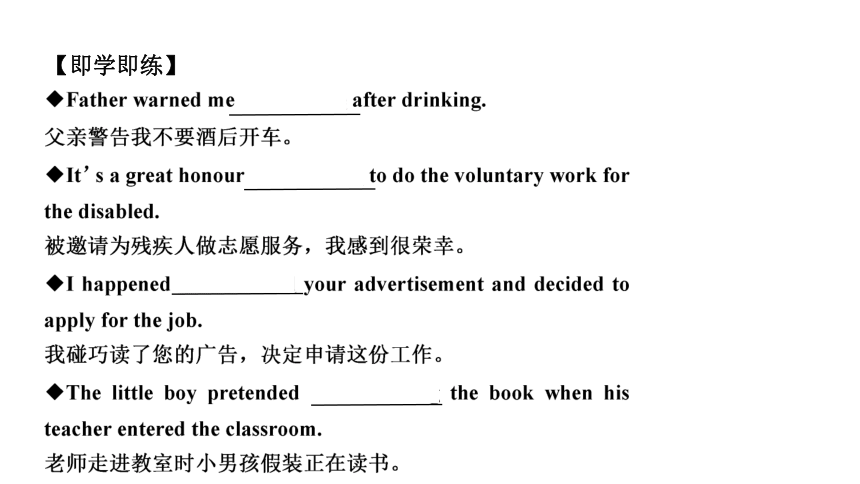
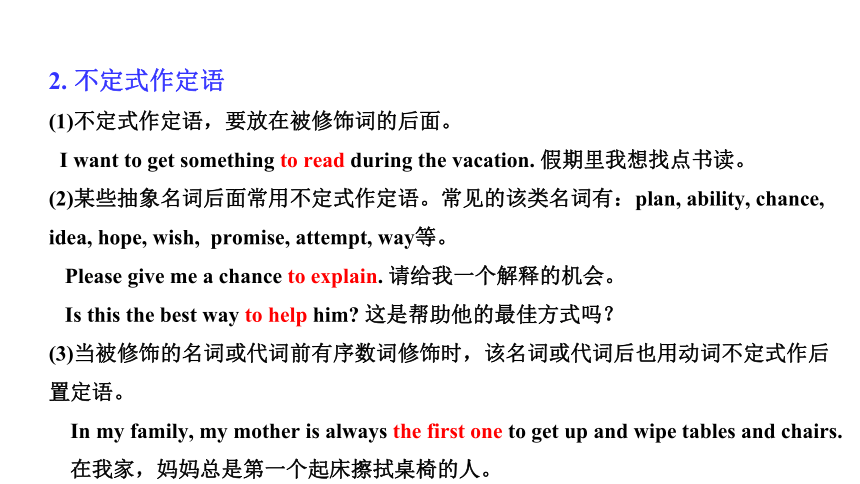
文档简介
(共21张PPT)
Period 2 Using language
Unit 3 On the move
1. To learn about to-infinitive as attributive and adverbial of result.
2. To use to-infinitive properly.
Learning aims
Dad, can I have a Pingpang ball to play
Darling,when you are old enough to play it, I will show you how to do it.
Leading-in
What is the function of to-infinitive in sentences Is it used to give description or show result
Grammar
to-infinitive as attributive and adverbial of result
(1)若不定式的动作发生在谓语动作之后,不定式用一般时。
* I hope to see you again. 我希望再见到你。
(2)若不定式的动作与谓语动作同时发生,并强调动作正在进行或持续进行,不定式用进行时。
*He pretended to be doing his homework when his father came in.
当他父亲进来时他假装正在写作业。
(3)若不定式的动作发生在谓语动作之前或强调动作已经发生,不定式用完成时。
*She seems to have seen this film.她似乎已看过这部影片。
(4)动词不定式的被动语态:表示与逻辑主语之间的被动关系。
* She asked to be treated equally. 她要求被公平对待。
【即学即练】
2. 不定式作定语
(1)不定式作定语,要放在被修饰词的后面。
I want to get something to read during the vacation. 假期里我想找点书读。
(2)某些抽象名词后面常用不定式作定语。常见的该类名词有:plan, ability, chance, idea, hope, wish, promise, attempt, way等。
Please give me a chance to explain. 请给我一个解释的机会。
Is this the best way to help him 这是帮助他的最佳方式吗?
(3)当被修饰的名词或代词前有序数词修饰时,该名词或代词后也用动词不定式作后置定语。
In my family, my mother is always the first one to get up and wipe tables and chairs.
在我家,妈妈总是第一个起床擦拭桌椅的人。
(4)不定式与所修饰词之间的关系
①主谓关系
被修饰的名词或代词实际上是不定式的逻辑主语。
*We need someone to help with the work.(someone will help with the work)
我们需要有人来帮忙做这项工作。
②动宾关系
被修饰的名词或代词是动词不定式的逻辑宾语。
*I have many letters to write.(to write many letters)我有许多信要写。
③同位关系
不定式与所修饰的名词指的是一回事。
*We have made a plan to learn from Lei Feng.
我们制订了一个向雷锋学习的计划。
④状语关系
被修饰的名词实际上表示动词不定式动作的方式、时间等。这些名词是抽象名词。
*That's the way to do it.那样做才对。
*I have no time to go there.我没有时间去那儿。
(5) 不定式与其所修饰的词构成逻辑上的动宾关系,而该不定式为不及物动词时, 其后须加上适当的介词,构成及物动词短语。
I am looking for a room to live in. 我正在找个房间住。
I need a piece of paper to write on.我需要一张写字用的纸。
There is nothing to worry about.没什么可担心的。
不定式作定语且所修饰的名词是time,place或way时,不定式后的介词一般要省去。
He had no money and no place to live.他没有钱也没有地方住。
3. 不定式作结果状语
动词不定式作结果状语的几种情况:
(1)动词不定式表示结果时通常用基本形式且总是出现在句尾,其逻辑主语就是句子的主语。结果状语常常只限于learn,find,see,hear,be told,make(使得)等动词。
*He returned home to learn his daughter had just been engaged.
他回家后得知女儿刚刚订婚了。
*I had to shout to be heard.
我必须叫喊对方才能听得见。
(2)only to do 结构表示意外的结果,分词与不定式都可以作结果状语,但不定式经常表示一种出乎意料的、令人不快的情况,而分词表示的是自然而然的结果。
*He hurried to the station,only to find the train had left.
他匆匆忙忙赶到车站,结果却发现火车已经离开了。
*His parents died,leaving him an orphan.
他父母双亡,成了一名孤儿。
(3)enough to do 结构
*The boy is old enough to take care of himself.
这个男孩够大了,可以自己照顾自己。
(4) so/ such... as to可作结果状语。例如:
She was so angry as to be unable to speak. 她气得连话都说不出来。
(5)too...to结构中,也是不定式作结果状语。
He is too young to get dressed. 他太小了还不会穿衣服。
Join the sentences using the to-infinitive form.
The rules of the game are simple enough to make the game easy to play.
The ball is small enough to fit into most sports bags.
Give me a list of the teams to enter into the competition.
The footballer has a dream to play for a top team.
We arrived at the stadium to find that the game had
been cancelled.
【即学即练】
Summary
Ⅰ.单句语法填空
1.These facts are enough (prove) that she is right.
2.I was watching the clock all through the meeting, as I had a
train (catch).
3.You lose weight for a while, only (gain) back more weight when you
stop your weight loss program.
4.As the famous saying goes, “It is never too late (learn).”
5.I paid a visit to Jason last night, only (tell) he had gone to Beijing on
business.
Exercise
to prove
to catch
to be told
to gain
to learn
To pay
to think
to exchange
to read
To make
Ⅱ.完成句子
1.She decided to work harder the others.
她决定更加努力学习以赶上别人。
2.I have no chance with so much work to do.
有这么多工作要做,我没有机会外出观光。
3.The best way is to bury yourself in your work.
忘掉悲伤的最好方法是将自己投入到工作中去。
to catch up with
to go sightseeing
to forget your sadness
4.I was very glad the homeless woman.
帮助了那位无家可归的妇人,我感到非常高兴。
5.We arrived in Beijing, that the flight to Guangzhou had been cancelled because of weather conditions.
我们到了北京,结果发现去广州的航班由于天气状况被取消了。
to have helped
only to find
Period 2 Using language
Unit 3 On the move
1. To learn about to-infinitive as attributive and adverbial of result.
2. To use to-infinitive properly.
Learning aims
Dad, can I have a Pingpang ball to play
Darling,when you are old enough to play it, I will show you how to do it.
Leading-in
What is the function of to-infinitive in sentences Is it used to give description or show result
Grammar
to-infinitive as attributive and adverbial of result
(1)若不定式的动作发生在谓语动作之后,不定式用一般时。
* I hope to see you again. 我希望再见到你。
(2)若不定式的动作与谓语动作同时发生,并强调动作正在进行或持续进行,不定式用进行时。
*He pretended to be doing his homework when his father came in.
当他父亲进来时他假装正在写作业。
(3)若不定式的动作发生在谓语动作之前或强调动作已经发生,不定式用完成时。
*She seems to have seen this film.她似乎已看过这部影片。
(4)动词不定式的被动语态:表示与逻辑主语之间的被动关系。
* She asked to be treated equally. 她要求被公平对待。
【即学即练】
2. 不定式作定语
(1)不定式作定语,要放在被修饰词的后面。
I want to get something to read during the vacation. 假期里我想找点书读。
(2)某些抽象名词后面常用不定式作定语。常见的该类名词有:plan, ability, chance, idea, hope, wish, promise, attempt, way等。
Please give me a chance to explain. 请给我一个解释的机会。
Is this the best way to help him 这是帮助他的最佳方式吗?
(3)当被修饰的名词或代词前有序数词修饰时,该名词或代词后也用动词不定式作后置定语。
In my family, my mother is always the first one to get up and wipe tables and chairs.
在我家,妈妈总是第一个起床擦拭桌椅的人。
(4)不定式与所修饰词之间的关系
①主谓关系
被修饰的名词或代词实际上是不定式的逻辑主语。
*We need someone to help with the work.(someone will help with the work)
我们需要有人来帮忙做这项工作。
②动宾关系
被修饰的名词或代词是动词不定式的逻辑宾语。
*I have many letters to write.(to write many letters)我有许多信要写。
③同位关系
不定式与所修饰的名词指的是一回事。
*We have made a plan to learn from Lei Feng.
我们制订了一个向雷锋学习的计划。
④状语关系
被修饰的名词实际上表示动词不定式动作的方式、时间等。这些名词是抽象名词。
*That's the way to do it.那样做才对。
*I have no time to go there.我没有时间去那儿。
(5) 不定式与其所修饰的词构成逻辑上的动宾关系,而该不定式为不及物动词时, 其后须加上适当的介词,构成及物动词短语。
I am looking for a room to live in. 我正在找个房间住。
I need a piece of paper to write on.我需要一张写字用的纸。
There is nothing to worry about.没什么可担心的。
不定式作定语且所修饰的名词是time,place或way时,不定式后的介词一般要省去。
He had no money and no place to live.他没有钱也没有地方住。
3. 不定式作结果状语
动词不定式作结果状语的几种情况:
(1)动词不定式表示结果时通常用基本形式且总是出现在句尾,其逻辑主语就是句子的主语。结果状语常常只限于learn,find,see,hear,be told,make(使得)等动词。
*He returned home to learn his daughter had just been engaged.
他回家后得知女儿刚刚订婚了。
*I had to shout to be heard.
我必须叫喊对方才能听得见。
(2)only to do 结构表示意外的结果,分词与不定式都可以作结果状语,但不定式经常表示一种出乎意料的、令人不快的情况,而分词表示的是自然而然的结果。
*He hurried to the station,only to find the train had left.
他匆匆忙忙赶到车站,结果却发现火车已经离开了。
*His parents died,leaving him an orphan.
他父母双亡,成了一名孤儿。
(3)enough to do 结构
*The boy is old enough to take care of himself.
这个男孩够大了,可以自己照顾自己。
(4) so/ such... as to可作结果状语。例如:
She was so angry as to be unable to speak. 她气得连话都说不出来。
(5)too...to结构中,也是不定式作结果状语。
He is too young to get dressed. 他太小了还不会穿衣服。
Join the sentences using the to-infinitive form.
The rules of the game are simple enough to make the game easy to play.
The ball is small enough to fit into most sports bags.
Give me a list of the teams to enter into the competition.
The footballer has a dream to play for a top team.
We arrived at the stadium to find that the game had
been cancelled.
【即学即练】
Summary
Ⅰ.单句语法填空
1.These facts are enough (prove) that she is right.
2.I was watching the clock all through the meeting, as I had a
train (catch).
3.You lose weight for a while, only (gain) back more weight when you
stop your weight loss program.
4.As the famous saying goes, “It is never too late (learn).”
5.I paid a visit to Jason last night, only (tell) he had gone to Beijing on
business.
Exercise
to prove
to catch
to be told
to gain
to learn
To pay
to think
to exchange
to read
To make
Ⅱ.完成句子
1.She decided to work harder the others.
她决定更加努力学习以赶上别人。
2.I have no chance with so much work to do.
有这么多工作要做,我没有机会外出观光。
3.The best way is to bury yourself in your work.
忘掉悲伤的最好方法是将自己投入到工作中去。
to catch up with
to go sightseeing
to forget your sadness
4.I was very glad the homeless woman.
帮助了那位无家可归的妇人,我感到非常高兴。
5.We arrived in Beijing, that the flight to Guangzhou had been cancelled because of weather conditions.
我们到了北京,结果发现去广州的航班由于天气状况被取消了。
to have helped
only to find
